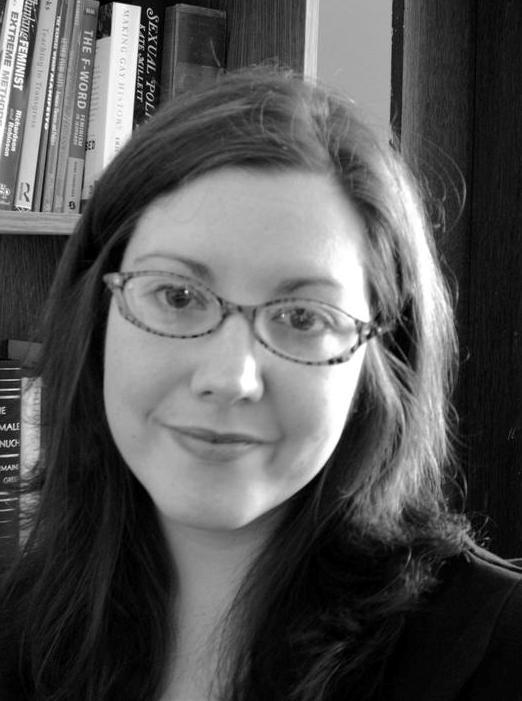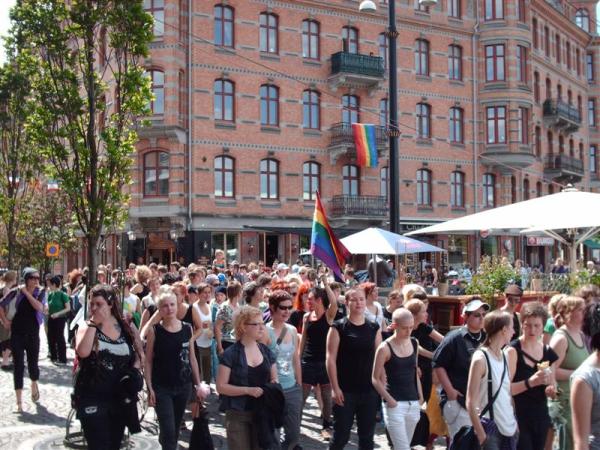
I arrived at Kvinnofolkhögskolan (The Women's Folk High School) at 10:00 on a Friday morning in June. I entered the school along with three young Swedish women who helped me navigate my way from the street to the school’s side entrance. After signing in, I walked up the stairs and entered the school cafeteria, where I found a small group of young women talking, laughing, blowing up balloons, and listening to music. A large blue banner with curvy lettering covered one wall of the cafeteria. It read, “Bye bye hetero-norm, hej hej kärleks-storm.” (Bye Bye hetero-norm, hi hi love-storm)
The Professional Stranger
From the moment I set foot inside Kvinnofolkhögskolan, site of the annual Lesbisk Aktion (Lesbian Action) festival, I became a “professional stranger” for 5 weeks.[1] I traveled to Sweden and Norway in May and June 2007 to conduct preliminary interviews for what will become my doctoral dissertation in sociology at the University of Pittsburgh (USA). It was my first time working and conducting fieldwork in other countries, and during the course of my stay, I felt emotions ranging from anxiety and downright fear to delight and pure exhilaration. Even the simplest social interactions took on new meaning. For example, asking a group of activists if I, the stranger, can join their lunch table still inspires the sort of anxiety experienced by “the new kid” trying to find a seat in a crowded high school cafeteria.

I spent time with feminist activists in Gothenburg, Stockholm, and Oslo to learn about the relationships between gender, sexuality and activism. What is the activist ‘scene’ like in Sweden and Norway? What is the role of gender and sexual politics in Scandinavian extraparliamentary movements? In Gothenburg and Stockholm, I explored these questions in various ways: I interviewed activists, both formally and informally; participated in a conference on Global Women's Activism and a lesbian-feminist demonstration; and attended lesbian and HBT (homosexual, bisexual, transgender) festivals. In Oslo, I was a guest researcher at the Nordic Institute for Women’s Studies and Gender Research (NIKK) for the month of June, where I had valuable access to libraries and other research centers at the University of Oslo. I was able to make contact with several groups and individuals who taught me about extraparliamentary movements in Norway, as did attending Skeive Dager (Queer Days) events to learn about Norwegian queer groups and activist networks.
Why Sweden and Norway?
One of the first questions I am always asked is, “why study Scandinavia?” After all, my previous research focuses on sexuality activism within small, localized, American women’s collectives. I visited Scandinavia for the first time in 1995, and in retrospect, it was a summer of many character-building firsts. It was the first time I traveled independently, left my family behind, and experienced major culture shock, in part due to class differences between my family at home and my Swedish hosts. Most importantly, it was the first time I felt a connection to a place and to people who were not my own. Therefore, when several factors converged—including a 2006 visit to the University of Oslo and the advice of a Swedish colleague—I could not resist the opportunity to delve into international research.[2]
In addition to personal reasons, there are more intellectual reasons for my choice to study the region than I can enumerate here. Sweden is home to one of the most well-known extraparliamentary left movements in Europe. Gothenburg activists gained international attention during the EU Summit in 2001, after which more than 60 protesters were sentenced to a combined total of nearly 50 years in prison. Norway provides an interesting contrast, since radical left subcultures are much smaller and “less aggressive” than their Swedish counterparts. [3] My visit was timely, as they had just made international headlines during the NATO Summit protests in Oslo in April 2007.
Impressions and Future Directions
I was often touched by the candor and enthusiasm of people with whom I came into contact this summer. Women offered me their time, their stories, and their unabashed thoughts on topics such as lesbian motherhood and reproductive rights, prostitution, pornography, power relations, and sexual violence. I was deeply impressed by women who spoke candidly about exclusion from social groups—including activist communities—based on gender, sexuality, age, social connections, and even style. I was also intrigued by the ways in which activists discuss questions of international solidarity, particularly with regard to HBT activism. Careful attention is given in workshops and meetings to how Scandinavian activists might best mobilize internationally, while avoiding the perils of cultural imperialism and western hegemony.

Because Scandinavian research and activist communities are small and tight-knit, I was relieved and grateful for the kindness and helpfulness with which I was met by activists and academics alike. My work this summer was exploratory, so my future directions are not yet clearly mapped out. I do know that I will search deeper within extraparliamentary leftist culture; I believe that these communities can offer new and interesting directions in research on gender and social movements, particularly with regard to identity, ideology, and sexual politics. When I return to Scandinavia for an extended period of dissertation fieldwork, I am sure I will experience familiar feelings that alternate between anxiety and excitement. However, my experience this summer makes me confident in my commitment to scholarship on gender and sexuality in Scandinavia and in my capabilities as a professional stranger.
_________________________
[1] The term “professional stranger” was coined by ethnographer Michael H. Agar in his book of the same name.
[2] Here I must acknowledge Cathrin Wasshede, a doctoral student at Gothenburg University, who very kindly put me in touch with activists and shared with me early findings from her own work on constructions of gender and sexuality in the extraparliamentary left in Gothenburg.
Kimberly Creasap is currently a Ph.D. student in sociology at the University of Pittsburgh (Pennsylvania, USA) and holds a master’s degree in women’s studies from Eastern Michigan University. She also studied at the Summer Institute on Sexuality, Culture and Society, Universiteit van Amsterdam. In June 2007, she was a guest researcher at the Nordic Institute for Women's Studies and Gender Research (NIKK) in Oslo where she conducted preliminary research on Scandinavian sexualities, feminisms, and extraparliamentary left subcultures. She is currently working on her dissertation proposal as well as a paper on contemporary lesbian-feminist activism in Sweden.
